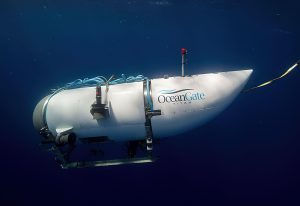Did OceanGate exaggerate partnerships with Boeing, the University of Washington and NASA?
 OceanGate, the company responsible for the lost Titanic tourist submersible likely overstated the details of its partnerships in the development and engineering of the TITAN submersible. This was likely an effort to legitimize the unclassified submersible, which was built with a carbon fiber hull and titanium end caps.
OceanGate, the company responsible for the lost Titanic tourist submersible likely overstated the details of its partnerships in the development and engineering of the TITAN submersible. This was likely an effort to legitimize the unclassified submersible, which was built with a carbon fiber hull and titanium end caps.
The fatal implosion of the TITAN submersible, a vessel OceanGate once hailed as the “beginning of a new era of exploration,” raises unresolved questions about how the startup was able to operate the vessel and persuade individuals to become high-paying customers in this field of adventure tourism.
In various public statements, the company claimed that the TITAN submersible was designed and engineered with assistance from Boeing, the University of Washington, and NASA. However, each of these entities has described their involvement as more limited than OceanGate sometimes indicated.
The now inaccessible website content and marketing materials described the TITAN submersible as “The state-of-the-art vessel, designed and engineered by OceanGate Inc. in collaboration [with] experts from NASA, Boeing and the University of Washington.”
Kevin Williams, the executive director of the University of Washington’s Applied Physics Laboratory, stated that neither the school nor the laboratory participated in the “design, engineering, or testing” of the TITAN submersible.
“The University’s and Laboratory’s engineering partnership with OceanGate ended with the completion of the shallow water vessel CYCLOPS, which served as a test platform for OceanGate since 2015,” said Kevin Williams. “Because APL-UW expertise involved only shallow water implementation, the Laboratory was not involved in the design, engineering or testing of the TITAN submersible used in the RMS TITANIC expedition.”
UW spokesperson Victor Balta added that OceanGate and the UW Applied Physics Laboratory initially signed a $5 million collaborative research agreement, but the two entities “parted ways” after completing only $650,000 of the work. According to Balta, that research resulted in the development of another OceanGate submersible, the shallow-diving CYCLOPS I. Balta added that OceanGate contracted with the school to use testing tanks on a contractual basis for nine tests between 2016 and 2022.
“No UW researchers were involved in any of those tests and UW personnel did not provide any verification or validation of any OceanGate equipment as a result of those tests,” Balta said in a statement.
OceanGate stated that the steel-hulled CYCLOPS I was rated for depths up to 500 meters, whereas the TITAN, made from carbon fiber and titanium, could reach depths of 4,000 meters.
In a 2021 press release, OceanGate thanked “industry partner” Boeing for their “design and engineering support” related to the TITAN submersible. When asked about the relationship between the two companies, a Boeing representative stated, “Boeing was not a partner on the TITAN and did not design or build it.”
OceanGate frequently mentioned its collaboration with NASA in press releases, expressing gratitude for the organization’s design and engineering support. However, a 2022 press release clarified NASA’s role, stating that a team of NASA engineers merely consulted during the project’s development and engineering phases.
“NASA’s Marshall Space Flight Center in Huntsville, Alabama, will serve as the facility where the development and manufacturing of a new aerospace-grade hull is completed,” OceanGate wrote in a 2020 press release. It was also stated that NASA would be involved in the testing of the “new carbon fiber pressure vessels.”
NASA confirmed that it provided consultation on materials and manufacturing for the TITAN submersible as part of an agreement with OceanGate but denied that they were involved in any testing or manufacturing. “NASA did not conduct testing and manufacturing via its workforce or facilities, which was done elsewhere by OceanGate,” a statement said.
OceanGate leveraged the strength of its claimed industry partnerships to build credibility with both industry groups like the Marine Technology Society and the public, who were potential buyers of the $250,000 tickets for OceanGate’s expeditions.
“[OceanGate] has invested six years of design and testing of this pressure vessel design in partnership with technology organizations such as the Applied Physics Lab at the University of Washington and the Boeing Company,” the Marine Technology Society noted in its 2017-18 global industry overview of manned underwater vehicles. “OceanGate reports this has given the company full confidence in their novel approach…”
The Marine Technology Society (MTS) outlined and “collectively expressed unanimous concern” regarding the development of TITAN and OceanGate’s expedition to the Titanic wreckage.
“Our apprehension is that the current experimental approach adopted by OceanGate could result in negative outcomes (from minor to catastrophic) that would have serious consequences for everyone in the industry,” a letter said.
The group expressed concerns about OceanGate’s marketing materials claiming that the TITAN design will meet or exceed DNV-GL safety standards, “It does not appear that OceanGate has the intention of following DNV-GL class rules. Your representation is, at minimum, misleading to the public and breaches an industry-wide professional code of conduct we all endeavor to uphold.”
This is a continuing story, and our firm will update this post as more information is made available.
 Maritime Injury Law Blog
Maritime Injury Law Blog

